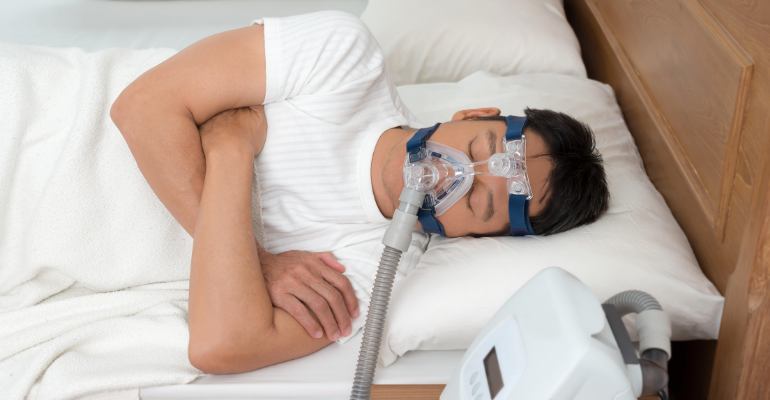FDA Inspection of a Philips Facility Raises Red Flags
An update from FDA regarding Philips Respironics ventilators and continuous positive airway pressure (CPAP) and bilevel positive airway pressure (BiPAP) machines raises questions regarding the safety of the company’s chosen replacement foam for the recalled devices.
Philips initiated a recall in June of more than 15 million ventilators and CPAP and BiPAP machines due to potential health risks related to the polyester-based polyurethane sound abatement foam used in the devices. This particular foam may degrade and emit small particles that irritate airways. FDA said this can result in serious injury, which can be life-threatening, cause permanent impairment and require medical intervention to prevent permanent injury to users.
After initiating the recall, Philips developed a plan to repair the polyester-based polyurethane foam in the recalled CPAP and BiPAP devices with a different, silicone-based foam. FDA initially approved this plan based, in part, on testing the company provided to the agency in June on the new foam. However, a recent FDA inspection of a Philips Respironics’ manufacturing facility revealed additional information, not previously available to the agency, regarding the silicone-based foam used in a similar device marketed outside the United States, which failed a safety test for the release of certain chemicals of concern, called volatile organic compounds. Similar testing provided by Philips to FDA on devices authorized for marketing in the United States had demonstrated acceptable results.
As a result, FDA has asked Philips to retain an independent laboratory to perform additional testing to determine what, if any, potential safety risks may be posed to patients by the silicone-based foam. The agency said it is aware that some patients have already received devices with silicone-based foam as part of the company’s repair and replace program. At this time, FDA said it does not have sufficient information to conclude whether the silicone-based foam being used in the repaired devices poses any risk to U.S. patients. FDA does not currently recommend patients who have participated in the repair and replace program discontinue use of their product because discontinuing use of these devices may be more harmful to a patient’s health and quality of life.
“We believe that the need for additional testing could slow Philips Respironics’ effort to repair or replace its recalled units,” said Mike Matson, a medtech analyst at Needham & Co. “They have previously estimated that it would take a year to complete the recall.”
If the recall is prolonged, that could be positive for ResMed, Matson said, as it would allow ResMed to capture additional market share and potentially retain a greater portion of that market share over time.
“We recognize that patients rely on these devices, and we are closely monitoring the company’s actions to ensure that the issues are resolved in a timely manner given the impact on patients,” said Jeff Shuren, MD, director of FDA’s Center for Devices and Radiological Health. “We are committed to continuing to regularly update the public about the status of this recall, including any new recommendations or actions regarding Philips Respironics’ devices.”
Philips knew about the foam degradation problem 6 years ago
During the recently completed inspection of the company’s Murrysville, PA-based facility, the FDA investigator made several observations that are outlined in an inspection closeout report (also known as an FDA Form 483). An FDA investigator’s list of inspection observations does not constitute a final FDA determination of whether any condition is in violation of federal regulations. FDA said it will review the company’s response and the totality of information available to the agency in determining appropriate next steps.
According to the investigator’s report, there is no documented investigation, risk analysis, or design failure mode effect analysis to support the company’s rationale for which polyester-based polyurethane foam-containing products were affected, included, or not included in the ongoing device recall that Philips initiated in June. The investigator noted that the justification document Philips provided does not sufficiently demonstrate that other devices containing the same type of foam shouldn’t be included in the recall as well.
The investigator’s report also points out that around Nov. 25, 2015, Philips was aware of a preventative maintenance servicing procedure implemented by another Philips entity on Trilogy ventilator products regarding foam degradation issues and complaints in the field. However, Philips Respironics either did not perform or did not document any further investigation, health hazard evaluation, risk analysis, or design review of the issue. The company did, however, provide the investigator with an email that the other Philips entity sent on Nov. 25, 2015, detailing the preventative maintenance procedure and timeline.
The investigator also noted on the report that there were at least 14 instances between April 1, 2016 and Jan. 22, 2021, where Philips Respironics was aware of potential foam degradation problems with various sleep and respiratory care devices, but the firm did not perform an adequate risk analysis within an appropriate time frame.
Information for patients about the Philips recall

As previously communicated, FDA recommends that patients currently using a recalled device that has not yet been repaired and replaced consult with their healthcare provider to determine whether they should continue using the device, switch to another product, or stop use.
The agency said it recognizes that many patients will have questions about what this updated information means for the status of their devices. FDA has worked with patients and professional organizations, including the American Sleep Apnea Association, the COPD (chronic obstructive pulmonary disease) Foundation, the Muscular Dystrophy Association, Mended Hearts, and the American Academy of Sleep Medicine, and has included this feedback in the updated “Frequently Asked Questions” to provide helpful information to the public.
Article source: Qmed and MD+DI









